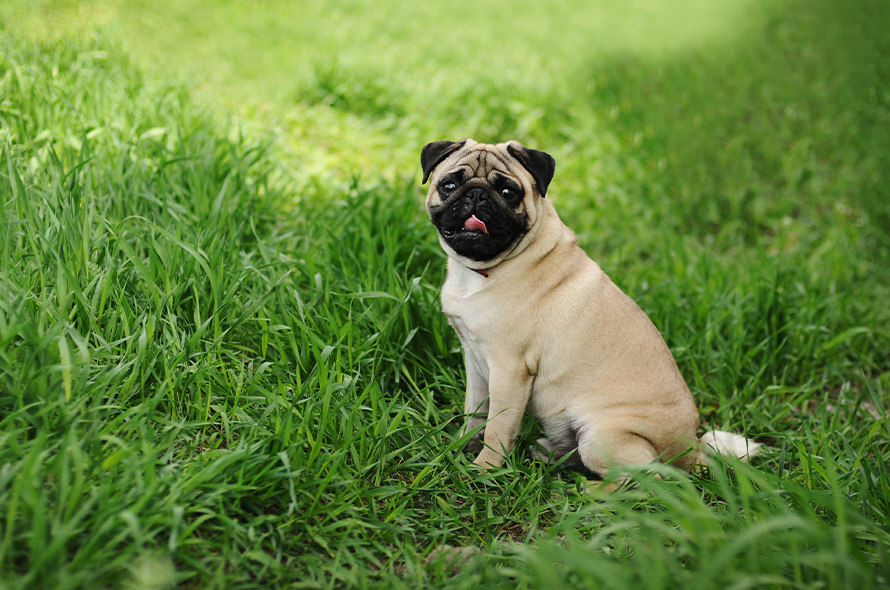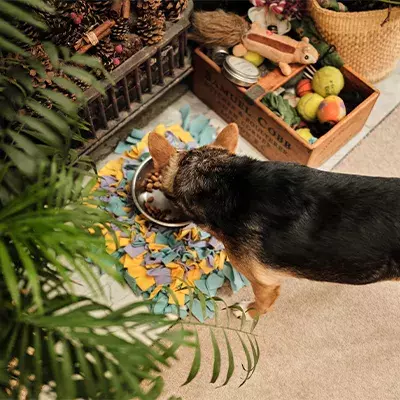Pugs are popular pets, but we frequently see them given up to Battersea. This is because people often underestimate the complexities of their medical needs and the level of care required.

What you need to know
- Average lifespan: 7-9 years
- Size: Small (6-8kg)
- Quality of life: Many Pugs are unable to breathe normally. This makes them more likely to overheat, struggle to exercise and some suffer significantly.
- Cost: In addition to day-to-day costs, you’ll need to prepare for higher insurance prices and a lifelong investment in care due to Pugs’ flat faces. They often need ongoing treatment for breathing problems which can mean expensive surgeries.
Health
Because of their flat faces and narrow airways, Pugs can have severe breathing issues that can cause distress or discomfort.
Treatment and costs
Expensive surgery can help some Pugs breathe better. But it doesn’t improve quality of life for every Pug.
Pugs are at high risk of intervertebral disc disease (IVDD). This is where a slipped disc puts pressure on the spinal cord and can cause pain, paralysis, or problems with walking and going to the toilet.
Treatment and costs
Treating IVDD often involves significant costs and time, including intensive nursing, physiotherapy, or even emergency surgery.
Pugs can develop itchy, irritated or sore ears and skin, often caused by underlying allergies. Their extra skin folds can often cause skin infections around the face and tail, which can be very painful and require regular treatment.
Treatment and costs
These are often lifelong conditions with regular, ongoing vet costs. Allergies can only be managed rather than cured, so Pugs with these issues will need regular vet check-ups and trial treatments to keep them under control. You may need to regularly give them special medicated baths. In extreme cases, surgery is needed to remove excess skin.
Some Pugs can develop problems that affect their bones, muscles or joints, including hip dysplasia and kneecap dislocation (patella luxation). These can occur from an early age and cause varying degrees of pain and arthritis over time.
Treatment and costs
Bone, muscle and joint problems need lifelong care and treatment. This can include regular vet visits and medication to manage mobility, pain and quality of life. Expensive surgery or hydrotherapy/physiotherapy may also be needed.
Pugs’ flat faces and big eyes can lead to dry or irritated eyes. These can become painful, infected, or cause long-term damage.
Treatment and costs
You may need to regularly monitor and clean your Pug’s eyes, give supportive treatment such as eye drops, and book regular vet visits. In some more serious cases, further treatment may be needed, which can become expensive.
Because of their face shape, Pugs can be prone to dental overcrowding, where they have too many teeth to sit comfortably in their mouths.
Treatment and costs
You’ll need to regularly brush your Pug’s teeth. Pugs that have this condition may need multiple dental procedures throughout their life to keep their mouths pain and infection free.
Good to know
Some reputable breeders will screen parents for certain health issues to reduce the chance of puppies developing them.
Behaviour, training and exercise
-
You’ll need to dedicate time and effort to separation training.
Pugs are prone to separation anxiety and can bark or become destructive when left alone without proper training. You will need to gradually teach your dog to handle time alone and keep a clear routine.
-
You’ll need to provide Pugs with lots of daily play like food puzzles and trick training.
This is because they can overheat or tire quickly because of their flat faces, so need to be provided with other forms of mental stimulation or they will become frustrated. They still need daily walks but you'll need to watch their breathing carefully.
- You’ll also need to keep your Pug busy to prevent them from getting bored and avoid destructive behaviours, like chewing or tearing at things. Providing mental stimulation - like puzzle feeders or snuffle mats - helps keep them happy.
Good to know
While a dog’s breed may influence how they behave, their behaviour will be shaped by all kinds of things, from their age to their life experiences.
Costs to consider
The cost of owning and keeping a dog healthy and happy is a long-term financial commitment. For a breakdown of how much it costs to own a Pug check out this calculator from the RSPCA.
As there are common medical issues associated with Pugs which can be expensive to treat, it’s important to consider how you would fund this. Pet insurance doesn't always cover all medical treatment, so you may need to pay some costs yourself.
Good to know
If you're considering getting a puppy from a breeder, it’s important to choose a reputable one. Check out this helpful guide on what to look for in a breeder and questions to ask.



